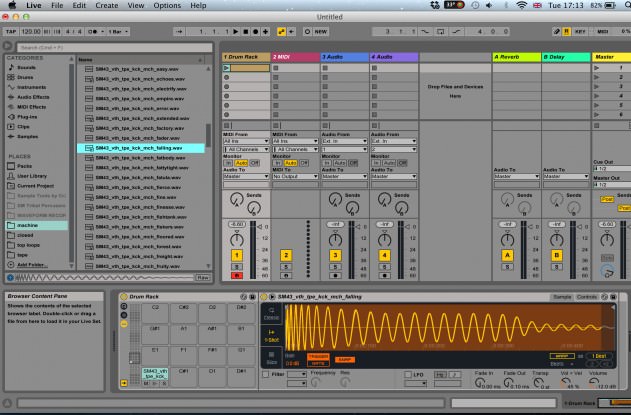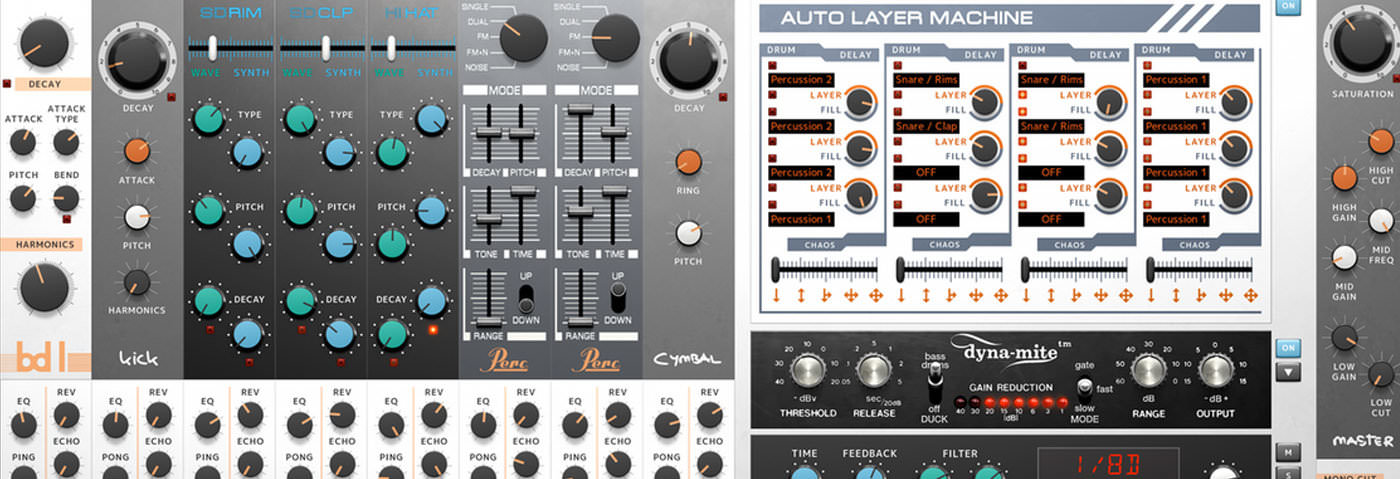Jonny Strinati walks through 11 essential drum techniques, from programming hi-hat patterns to compressing kicks.
Drum Layering Techniques in Ableton Live – Kick
We’ll use Drum racks in Ableton Live in this walkthrough to create a layered kick drum. Layering drums can be a very effective way to create customised drum sounds, as you’re selecting the strongest elements from each layer and have a great deal of control over each element. Here’s an example of the kick we’ll be creating, playing alongside a tops loop:
Step 1
Load the Drum Rack device in Ableton by clicking and dragging it over to a MIDI channel on the mixer. We’ll start by loading kick drum samples into our Drum Rack. Use the Places section on the left to navigate to wherever you have some samples stored on your computer. We’ve used the Vinyl & Tape Drum Hits library, and selected ‘SM43_vth_tpe_kick_mch_falling.wav’ from the Machine Kicks in the Tape Folder.
Now drag and drop your sample onto a MIDI channel on the Drum Rack (this creates a Simpler for our sample). We’ve placed our kick on C1. The first sound is a subby kick that’s going to provide the low-end energy for our layered kick.
Next, right-click on a Clip Slot on the Drum Rack channel to insert a MIDI clip, and draw in a kick pattern to trigger the sample.


Step 2
Now for a kick that has more snap and will take care of the transient. First, create a Group by right-clicking where you see the file name on the Device Title Bar of Simpler. Select Group from the drop down. This creates an instrument rack on C1, meaning we can stack up samples that will be triggered by this one MIDI note.
Click the Show/Hide Chain List button on the instrument rack to reveal our first kick sample and some volume, pan, mute and solo controls. Click and drag another sample and drop it in the space underneath our first sample. We’ve selected ‘SM43_vth_tpe_kick_mch_born.wav’ from the same samples folder.
This sample has a much more prominent transient, however the low frequency on both samples is clashing. In the Filter section for the second Simpler, select a hghi-pass filter and change the frequency to 271 Hz.
We’ll also change the envelope settings as we’re only concerned with the attack portion of this sample. We’ve set the attack to 0.00ms, decay to 347ms, sustain to -inf dB and release to 50.0ms.


Step 3
The transients of both kicks playing at the same time could potentially start causing phase issues, so let’s go back to our first sample and change the envelope settings. Click on the first sample in the instrument rack and select the Classic playback mode.
Now change the envelope settings to attack of 3.97ms, decay 60.0s, sustain -inf dB and release 698 ms. This softens the attack of this kick and also shortens the tail. Increase the release time if you want to keep the subby tail.

Step 4
The final element we could add to this kick is a hi-hat sample, which acts as a high frequency burst to help the kick cut through a mix and adds character. We’ve selected ‘SM43_vth_tpe_hh_clsd_machine.wav’ from the closed hi-hats folder on the same sample pack.
Again we apply a high-pass filter, setting the frequency at 2.52 kHz, and change the envelope settings to attack 0.00ms, decay 66.1ms, sustain -inf dB, release 50.0ms. As with the transient kick sample, we’re mostly concerned with the attack portion of this hi-hat sample.
For a final bit of tweaking, we bring down the volume of the hi hat to -1.2 dB, and the volume of the transient kick to -1.5 dB, balancing the levels of our individual layers.


12.37 AM
Christmas just arrives for me ! Thanks a lot for all this tutorials !
01.51 AM
10 essential drum techniques??? 10 tutorials on how to do this or that using very particular DAWS and Plugins. Total waste of time.
02.52 AM
I do like Attack and despite me mainly being into underground hip hop I play disco and some nu disco (which is house haha) and still love techno as in the minimalist Detroit sound, not bloody tech house. I DJ and come from a great position clubwise. Growing up in South London in the 80’s there was the soul scene then the warehouse, hip-hop, funk, Boogie, disco anthems, Kiss FM when it was a pirate was our Bible and on a Tuesday night there were prob 5 good clubs to go to, on a Saturday, 25 maybe. who knows. Then I lived and loved through 88- to about 93 when the original Balearic, anything went, all about the tunes was starting to go slowly and it was about the DJs and had split into 1000 genres. Boys Own, Slam, and others still kept a more undergrounf scene going away from momeymakers like MOS. (only time I went there I lost my mates within about 20 mins and looked in vain for a few hours. That wasn’t what it was about. I was in Brighton then anyway and we had the wonderful Zap. Now what we got? A weekly decent hip hop night on a Tuesday, once a month clubs like Russ Dewbury’s terrific Soulful Strut where I do the odd slot.. All the sefront clubs which were once cool are now for the geezer and hen night crowd.Then there’s patterns. If there is a decent DJ it;s worth it. If not it;s the usual kid playing his perfect and completely broring seamless tech house set. The crowd don’t actuyally seem like they are having a particularly great time and most people in their 20’s just go to the pub and I’m not surprised. Your ‘What makes a great DJ’ was terrific as it so backed up what had happened. Itl;s turned on it’s head so instead of buying tunes as u knew they would be bangers I can tell that tracks are downloaded ‘cos they fit in with other tracks, I call it anti-DJing and it’s nice to see Attack interview some of the greats like Derrick May etc. You would think that the kids who think they are DJs now (despite there not being many places to DJ) would respect people like that. Indie kids in bands worship those who went before but no…they think they know best, they DJs who shock horror mixed with vinyl and would drop lots of banging tunes on the One as we punters couldn’t have cared less about the mixing really. It was all about the tunes, Depressing really. Good that the drum and bass scene and a few others have kept going by not becoming commercial. Sad thing is in Brighton there are loads of us that want to put proper small nights on with little risk like u used to be able to but there’s no where to hire out now.
Anyway I think all that was saying that you seem to be taking a more mature approach instead of articles like one I saw online which was “Is it possible to mix without using your EQ?” I just stared at it tbh in horror. The only time I tounch my EQ is when I turn the bass down for scratching. Oh couple of requests. How about a few more Beat Dissected on hip hop. The Underground has all kinds of leftfield beats and talented producers, and more minimalist techno. We of a certain age could make a house beat in our sleep. And can you please not make your tutorials so expensive plugin specific? We donl;t all use or can afford Ableton, Pro Tools, etc. I use Reaper, MPC Element and the best free plugins and synths that I have found. I’m sure Variety of Sound and Tokyo Dawn plugins could give a lot of commerial ones a run for their money. And making hip hop TyrellN6, Firebird and SQ8L certainly do the job. The only plugins I’be bought are the DopeVST Hip Hop romplers. And how about some tips on leftfield hip hop? Do people really still actually make ‘House Leads?’ I have about 50 in various presets that sound alright. Andy
08.19 PM
Thanks for all these tips, great article!
11.43 AM
This seems to be an advert for various (expensive) plugins rather than a tutorial on essential drum techniques. This should have been done using a DAW’s native plugins.